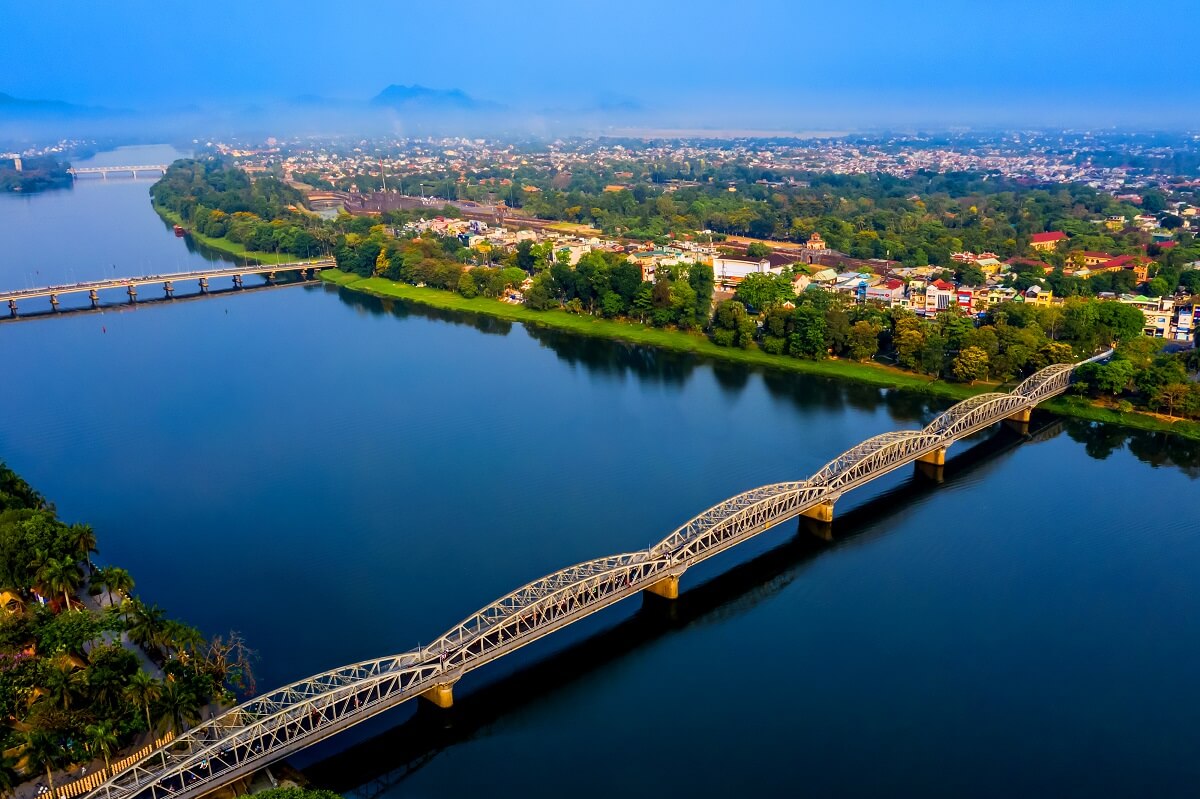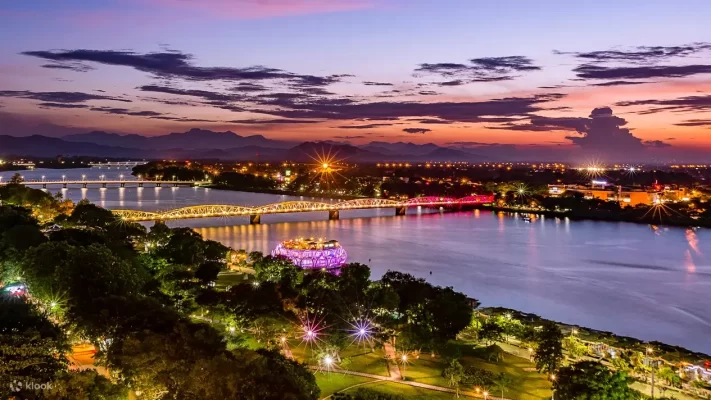Category Archives: Hue Travel Guide
Hue, Vietnam: A Historical and Cultural Travel Guide
Introduction to Hue Hue, once the illustrious capital of Vietnam, is a city that brims with historical significance and cultural depth. Renowned for its World Cultural Heritage Sites, Hue’s legacy spans from the rule of the Nguyen Lords (1558-1789) to the Nguyen Emperors (1802-1945). For 143 years, it stood as the heart of Vietnam under the Nguyen Dynasty until the advent of Ho Chi Minh’s Communist Government, which relocated the capital to Hanoi in 1945.
The Citadel of Hue The region’s history predates the 2nd century, with Chinese dominance until 192, when local forces established the nation of Lin Y. By the 4th century, the Champa Kingdom emerged, lasting until 1306 when a matrimonial alliance between Champa King Che Man and Vietnamese Princess Huyen Tran granted the lands of Châu Ô and Châu Lý to the Vietnamese monarchy.
The Vietnamese Civil War (1558-1789) saw the Nguyen Lords govern this area, while the Trinh Lords held sway over North Vietnam. Phu Xuan, now known as Hue, served as the Nguyen Lords’ stronghold against the Trinh Lords, who were based in present-day Hanoi.
Dynastic Shifts In 1789, Nguyen Hue overthrew both the Nguyen and Trinh families, initiating the Tay Son Dynasty. However, Nguyen Anh of the Nguyen lineage survived, reclaiming power in 1802 and establishing the Nguyen Dynasty, with Hue as the national capital.
During its tenure as capital (1802-1945), Hue witnessed the reign of 13 Nguyen Emperors. The French occupation began in 1858, culminating in full control by 1883. The Nguyen Dynasty concluded with King Bao Dai’s abdication on August 30, 1945, following World War II, and Ho Chi Minh declared Hanoi the capital of the newly formed Democratic Republic of Vietnam on September 2, 1945.
Climate of Hue Hue is characterized by a tropical monsoon climate, with temperatures ranging from a high of to a low of , and an annual average temperature of (78.02°F). The city receives an average annual rainfall of 1446.2 millimeters (56.94 inches).
Monthly Weather Averages
| Month | High / Low (°C) | Rainfall Days |
|---|---|---|
| January |
23.0 / 19.0 |
17.6 |
| February |
25.0/ 19.3 |
10.6 |
| March |
27.8/ 21.2 |
12.4 |
| April |
30.3 / 23.2 |
11.5 |
| May |
38.1/ 25.4 |
10.5 |
| June |
39.0/ 25.6 |
8.8 |
| July |
38.3/ 25.1 |
11.7 |
| August |
35.1/ 25.1 |
12.0 |
| September |
32.9/ 24.6 |
13.3 |
| October |
28.0/ 20.9 |
17.1 |
| November |
25.9/ 17.9 |
19.5 |
| December |
23.1/ 16.6^\ |
18.9 |
Optimal Travel Period The ideal time to visit Hue is from January to April, with pleasant average temperatures between
20and 24. Although rainfall is frequent, it typically presents as a gentle drizzle, allowing for comfortable exploration of Hue’s historic sites and temples on foot.
This guide aims to provide a comprehensive overview of Hue’s rich history and climate, ensuring travelers can plan their visit with a deeper appreciation of the city’s past and present.
Exploring Hue’s Heritage: Top Attractions
Hue Citadel Complex The Hue Citadel, encompassing the Imperial City and Forbidden Purple City, is a monumental complex constructed between 1804 and 1833 under the reigns of King Gia Long and King Minh Mang. This UNESCO World Cultural Heritage Site served as the residence and administrative center for the Nguyen Dynasty until 1945. It stands as a testament to Vietnam’s royal history and culture, making it an essential visit for those intrigued by the nation’s past.
Thien Mu Pagoda Perched on the northern banks of the Perfume River, approximately 3km from the Imperial Citadel, lies the Thien Mu Pagoda. Accessible by a scenic dragon boat ride or a refreshing bicycle journey, this pagoda is an emblematic symbol of Hue. It houses the Austin Motor Vehicle associated with Thich Quang Duc’s historic self-immolation in 1963. The site remains a spiritual haven for monks and a revered pilgrimage destination.
Royal Mausoleums Scattered across Hue’s countryside are seven Royal Tombs, commemorating nine of the thirteen Nguyen Dynasty rulers. The most frequented tombs are those of Minh Mang, Tu Duc, and Khai Dinh, each reflecting the emperor’s life and legacy. The lesser-visited tombs, including those of Gia Long, Thieu Tri, Duc Duc (shared with Thanh Thai and Duy Tan), and Dong Khanh, offer unique insights into the dynasty’s history.
Thanh Toan Covered Bridge Echoing the design of Hoi An’s Japanese Bridge, the Thanh Toan Covered Bridge was initiated by Tran Thi Dao, a mandarin’s wife, between 1740 and 1746. It was constructed to facilitate village connectivity along the canal. In 1925, Emperor Khai Dinh commemorated Tran Thi Dao with an altar on the bridge, and her legacy continues to draw visitors to her resting place.
Dong Ba Market As central Vietnam’s largest marketplace, Dong Ba Market immerses visitors in authentic Vietnamese culture. Here, one can experience the vibrancy of traditional market life, from sampans to bazaars. The market offers a plethora of items, including local delicacies, handicrafts, and iconic conical hats, making it an ideal spot for cultural exploration and souvenir hunting.
Ho Quyen: Tiger – Elephant Arena Just 3km from Hue’s center, the Ho Quyen arena is a unique historical site where royal entertainment once took the form of tiger-elephant battles. Constructed in 1830 under Emperor Minh Mang, this arena is a fascinating, yet often overlooked, piece of Hue’s cultural tapestry.
Bach Ma National Park Spanning 40,000 hectares, Bach Ma National Park is a former French hill station offering a natural escape with hiking trails, waterfalls, and diverse wildlife. Visitors can experience the park’s breathtaking jungle walks and mountain vistas, ensuring an adventure amidst Vietnam’s pristine landscapes.
These attractions represent the rich cultural and historical fabric of Hue, inviting travelers to delve into the city’s storied past and vibrant present. Whether seeking historical enlightenment or natural beauty, Hue offers an array of experiences to satisfy the curious explorer.
Elephant Springs (Suối Voi) Nestled 60 kilometers from Hue, Elephant Springs is a serene natural retreat. The spring’s namesake waterfall cascades into a refreshing pool, perfect for a cooling swim on a warm day. Visitors can glide down the waterfall’s smooth rocks or explore the tranquil spots further upstream.
Thuan An Beach A mere 14 kilometers from Hue’s city center, Thuan An Beach is a hidden gem of Central Vietnam. Despite its raw beauty, the beach remains remarkably unspoiled, with only a few rustic shacks dotting the landscape. The recent addition of Beach Bar Hue is infusing new life into the area, quickly becoming a favored day trip destination.
Dam Chuon Lagoon (Đầm Chuồn) Dam Chuon Lagoon, situated in An Truyen Village, is a peaceful escape 12 kilometers from Hue. This pristine lagoon is often bypassed by tourists, offering an authentic experience of local life. Visitors can embark on motorbike or bicycle tours to explore the surrounding villages, engage in fishing with locals, and savor a seafood lunch amidst the tranquil setting.
An Bang Cemetery (Nghĩa Trang An Bằng) In the quiet village of An Bang, the ‘City of Ghosts’ cemetery stands as a testament to the region’s cultural heritage. Located 20 kilometers east of Hue, near Thuan An Beach, the cemetery features an array of elaborate tombs and mausoleums, each telling a story of the past.
Free Attractions in Hue For those seeking cost-free experiences in Hue, the city offers a wealth of cultural and natural attractions. From historical sites to scenic landscapes, Hue provides ample opportunities for visitors to immerse themselves in the rich tapestry of Vietnamese heritage without any expense.
These highlights of Hue showcase the city’s diverse appeal, from its tranquil natural springs and unspoiled beaches to its culturally significant landmarks. Whether seeking relaxation or cultural enrichment, Hue’s offerings cater to a wide array of interests, ensuring a memorable visit for all.
Highlights of Hue Tourist Sites
Exploring Hue’s Heritage: Top Attractions Hue Citadel Complex The Hue Citadel, encompassing the Imperial City...
Hue Travel Guide
Hue, Vietnam: A Historical and Cultural Travel Guide Introduction to Hue Hue, once the illustrious...
Highlights Of Classy Hue Legacy Tours
Whether you’re strolling through ancient temples, admiring the architecture, or sampling street food, the Classy Hue...



